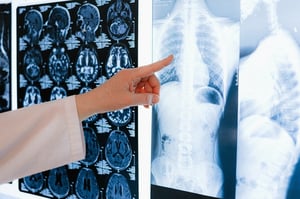Our nutritional needs evolve as we age, and ensuring we're getting the right vitamins and minerals...
Calcium and Aging: How to Ensure You Are Getting Enough
Calcium is a crucial mineral that plays a significant role in our overall health and well-being. It is particularly important as we age, as calcium deficiency can lead to a range of health issues, including osteoporosis, muscle weakness, and cardiovascular disease. As we get older, our bodies become less efficient at absorbing and utilizing calcium, making it even more critical to ensure we are getting enough through our diet or supplements.
In this blog post, we'll explore the relationship between calcium and aging and discuss how to ensure you are getting enough of this vital nutrient. From the best dietary sources of calcium to supplements and lifestyle changes that can support calcium absorption and utilization, we'll cover the information you need to keep your bones strong, your muscles healthy, and your heart functioning properly as you age. Whether you're in your 50s, 60s, or beyond, understanding the importance of calcium and how to maintain optimal levels can help you stay active, mobile, and independent for years to come.
Importance of Calcium
 Calcium is an essential mineral to live a healthy life. Calcium assists in maintaining the health of our bones and teeth by helping develop and maintain strong bone tissue. Around 99 percent of the calcium in our bodies is found in teeth and bones. It also helps our muscles to contract, our blood to clot, and our heart to beat. It may also have some anti-aging effects on the body.
Calcium is an essential mineral to live a healthy life. Calcium assists in maintaining the health of our bones and teeth by helping develop and maintain strong bone tissue. Around 99 percent of the calcium in our bodies is found in teeth and bones. It also helps our muscles to contract, our blood to clot, and our heart to beat. It may also have some anti-aging effects on the body.
Our bodies are incapable of producing calcium on their own. Therefore, it is critical for us to consume adequate calcium through our food. When the body does not obtain enough calcium for critical roles, it can extract it from the bones. While this is fine on occasion, bones become brittle and more likely to fracture if it occurs regularly.
Calcium requirements are determined by age. Because approximately half of all bone formation occurs during the teen years, calcium requirements are highest for teens. However, as you get older, your bones start to lose calcium. During the aging process, bones break down more than they build up. As a result, bones grow thinner and weaker over time. However, by increasing vitamin D and calcium intake, bone loss can be managed, and you can lower the risk of osteoporosis.
How to Get Enough Calcium
According to the Mayo Clinic, men ages 51-70 should consume 1,000 mg of calcium daily. Men 71+ and women ages 51 and older should consume 1,200 mg per day. Unfortunately, as Robert Wermers of the Mayo Clinic says, Americans, on average, are not receiving enough calcium from their diet. In the United States, women over the age of 50 consume 589-649 mg of calcium per day, while males consume 728-777 mg. According to Wermers, "After 50 years of age, it becomes more difficult to maintain calcium balance, and bone loss accelerates. Fractures become more likely as you become older".
The good news is that calcium can be found in a variety of food sources and supplements. However, calcium supplements should only be used if you aren't getting enough calcium from your diet and as recommended by your medical professional.
Which Foods Are Calcium-Rich?
When people hear the word "calcium," they frequently think of calcium-rich dairy products such as yogurt, milk, and cheese. While these are great options, there are several other good choices as well to increase your calcium intake!
 Low-fat dairy products contain nearly as much calcium as full-fat dairy products.
Low-fat dairy products contain nearly as much calcium as full-fat dairy products.- Calcium-rich non-dairy alternatives are also available for those who are lactose intolerant or wish to forgo dairy products.
- Almonds, broccoli, kale, brussels sprouts, collard greens, and Chinese cabbage are calcium-rich too.
- One can of salmon (with bones) contains about 20% of the daily recommended amount in a single 3-oz serving size.
- Kelp, quinoa, and okra are calcium-rich sides you can add to your dishes
Factors That Can Influence Calcium Absorption
The amount of calcium in foods varies significantly depending on their fat level. More fat tends to mean less calcium. Calcium absorption is proportional to the overall amount of calcium taken at one time. The more calcium consumed, the smaller the percentage of the calcium that is absorbed. As a result, calcium intake should be limited to 500 mg at a time.
Vitamin D, on the other hand, boosts calcium absorption. Vitamin D supplements with meals can help your body absorb calcium more effectively. Studies have demonstrated that athletes over the age of 60 who take supplements with vitamin D and calcium can increase their strength and athletic performance and decrease their risk of falling. However, while vitamin D aids calcium absorption, numerous other factors make calcium metabolism more difficult. For example, oxalic acid, found in dark green leafy vegetables, binds to calcium and prevents it from being absorbed by the body. Greens contain varying amounts of oxalic acid. So, if you want to eat more calcium-rich foods or take a calcium supplement, don't eat spinach, parsley, or rhubarb. Other factors that may affect calcium absorption include:
- Age — As your body's capacity for calcium absorption decreases with age, older persons must ingest extra calcium each day.
- Caffeine — The stimulant found in tea and coffee can enhance calcium excretion while decreasing absorption. One cup of standard brewed coffee, for example, depletes calcium by 2-3 mg.
- Alcohol — When consumed in large quantities, alcohol may impair calcium absorption and block some liver enzymes necessary for the active conversion of vitamin D. However, the exact amount of alcohol needed to affect calcium status is uncertain.
A healthy diet is essential to living a long and healthy life. In that way, it is critical to consume enough calcium to maintain good health. If you're concerned that you're not receiving enough calcium in your diet, speak with your doctor about strategies to increase your intake and maintain your bone health for many years to come.
Related Content:



-Sep-18-2024-12-51-25-6953-AM.jpg?width=600&name=file%20(10)-Sep-18-2024-12-51-25-6953-AM.jpg)


